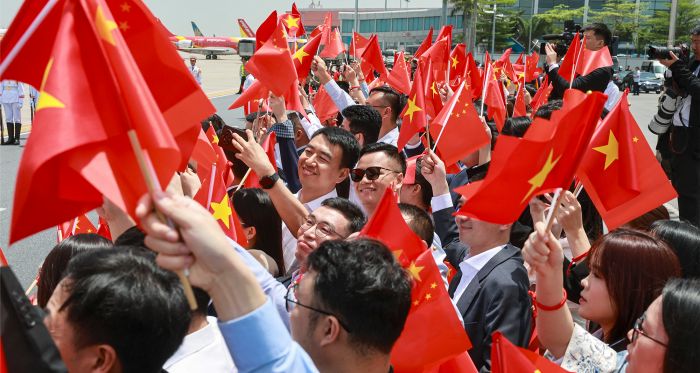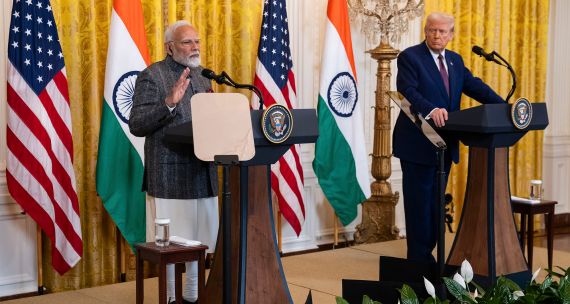Les tarifs douaniers réciproques annoncés par le président américain le 2 avril, qu’il qualifie de « Journée de libération », ont particulièrement affecté les économies de l’Asie du Sud-Est. Alors que ces pays et d’autres avaient ressenti un soulagement de courte durée avec un sursis de 90 jours accompagné d’un tarif généralisé de 10 %, les droits de douane sur les exportations chinoises ont été augmentés jusqu’à 145 %. La prise de décision politique, de plus en plus incohérente et erratique de l’administration américaine, pourrait décourager l’Asie du Sud-Est de conclure des accords commerciaux avec les États-Unis, qui deviennent un partenaire de moins en moins fiable.
En raison du raisonnement contestable de Trump concernant la fixation initiale des tarifs douaniers, les taux relativement élevés appliqués à la région pourraient s’expliquer par des motivations politiques. Les tarifs allant de 49 % pour le Cambodge, 46 % pour le Laos, 46 % pour le Vietnam, 44 % pour le Myanmar, 36 % pour la Thaïlande et 24 % pour la Malaisie et Brunei, visaient sans doute à exercer une pression sur ces pays en développement pour qu’ils reconsidèrent leurs liens économiques étroits avec la Chine.
Cependant, la stratégie de tarifs punitifs de Trump risque d’avoir l’effet inverse, car l’Asie du Sud-Est pourrait se détourner des États-Unis et se tourner vers les bras ouverts de la Chine. Le président chinois a d’ailleurs entamé des visites très médiatisées en Malaisie, au Cambodge et au Vietnam, du 14 au 18 avril, qui aboutiront invariablement à des engagements commerciaux et économiques bilatéraux de haut niveau, renforçant ainsi les liens de ces pays avec la Chine. L’offensive de charme de la Chine s’inscrit dans une démarche stratégique du président Xi, notamment en cette année où la Malaisie assure la présidence de l’Association des nations de l’Asie du Sud-Est (ANASE). Deux des pays les plus touchés par la première liste du 2 avril des tarifs réciproques – le Vietnam et le Cambodge – font justement partie de l’ANASE.
Avant le 2 avril, la plupart des pays d’Asie du Sud-Est refusaient de prendre parti dans la guerre commerciale opposant les États-Unis à la Chine. Toutefois, une enquête menée en 2025 par l’ISEAS-Yusof Ishak Institute sur l’Asie du Sud-Est a révélé que les pays de la région préfèreraient s’aligner sur les États-Unis plutôt que sur la Chine, s’ils étaient forcés de choisir. Cependant, les événements récents pourraient faire évoluer ce sentiment, d’autant que dans l’enquête de 2024, les répondants avaient préféré s’aligner sur la Chine plutôt que sur les États-Unis – signe que les économies d’Asie du Sud-Est s’apprêtaient déjà à réajuster leurs alliances en fonction de leurs intérêts stratégiques.
Il serait surprenant que les États-Unis parviennent à inverser cette tendance, alors même qu’ils auraient besoin d’alliés en Asie du Sud-Est, particulièrement dans le contexte persistant des différends sur la mer de Chine méridionale, où la Chine revendique des territoires maritimes contestés également par la Malaisie, les Philippines et le Vietnam. Même les Philippines, allié de longue date des États-Unis dans la région, se sont vu imposer des tarifs de 17 %.
Les pays exportateurs de semi-conducteurs en Asie du Sud-Est ont ressenti un soulagement lorsque les États-Unis ont exclu les semi-conducteurs de la liste du 11 avril des produits soumis aux tarifs de Trump, exemption finalement levée quelques jours plus tard. La Malaisie représente environ 20 % des importations américaines de semi-conducteurs, tandis que le Vietnam assure 10 % des importations de puces électroniques. Or, à mesure que les États-Unis changent de position sur cette exemption, il est possible que cela ne soit pas durable. Si certains produits d’exportation comme le cuivre, les produits pharmaceutiques, les semi-conducteurs et le bois d’œuvre ne figurent pas pour l’instant parmi les produits soumis aux tarifs réciproques annoncés le 2 avril, ils pourraient faire l’objet de nouvelles mesures tarifaires à l’avenir, au titre de la section 232 de la Loi sur le commerce de 1962.
Ces tarifs sur les semi-conducteurs ne doivent pas surprendre, car ce secteur représente précisément le type d’industrie manufacturière que Trump envisage de relocaliser aux États-Unis.
Trump a lui-même déclaré qu’il prévoyait d’imposer des tarifs allant jusqu’à 25 % sur les importations de semi-conducteurs. De plus, tous les semi-conducteurs ne sont pas exemptés actuellement, notamment les unités de traitement graphique et les serveurs dédiés à l’entraînement de modèles d’IA.
Si les tarifs généralisés de Trump envers l’Asie du Sud-Est sont appliqués, leurs effets seront plus sévères et durables. Les pays de l’ANASE, collectivement, représentent 7,2 % du PIB mondial en 2024 et 8,7 % de la croissance du PIB mondial durant les 10 dernières années (2014-2024). Si l’Asie du Sud-Est devait connaître une récession, les pays ayant le plus faible PIB par habitant, notamment le Myanmar, le Laos et le Cambodge, seraient plus durement touchés que d’autres. Le Myanmar, en proie à une guerre civile depuis 2021 et qui a récemment subi un séisme dévastateur ayant fait plus de 3 500 morts, se retrouverait ruiné.
Il circule déjà des informations selon lesquelles des investisseurs chinois établis en Chine continentale et au Vietnam cherchent à diversifier leurs bases manufacturières ailleurs dans la région. La Malaisie et les Philippines, qui sont confrontées à des tarifs relativement moins élevés, pourraient en tirer profit, mais ce serait aux dépens de leurs voisins. Entre-temps, les pays d’Asie du Sud-Est pourraient de plus en plus envisager d’imposer des barrières tarifaires sur les exportations chinoises afin de protéger leurs secteurs manufacturiers locaux, car les produits qui auraient dû atteindre les marchés américains seraient réorientés vers les marchés du Sud-Est asiatique. Cette démarche pourrait toutefois être économiquement contre-productive en raison de l’interconnectivité accrue des chaînes d’approvisionnement dans la région et de la dépendance commune à l’égard des produits chinois. Elle pourrait aussi aller à l’encontre des principes de centralité et d’intégration économique de l’ANASE.
En fin de compte, l’Asie du Sud-Est pourrait ne pas être en mesure de se libérer complètement des investissements directs étrangers américains, ceux-ci représentant 32,4 % du total des flux d’IDE dans la région en 2023. Par conséquent, tous les pays d’Asie du Sud-Est ont privilégié la diplomatie, ont envoyé des représentants à des fins de négociation et se sont engagés à travailler en étroite collaboration avec les États-Unis.
La Malaisie, tenant la présidence de l’ANASE en 2025, est à la tete d’une riposte régionale unifiée à l’annonce des tarifs du 2 avril. Durant la réunion économique extra-ordinaire des ministres de l’ANASE le 10 avril, le groupe a tenu une position commune pour s’engager dans un dialogue franc et constructif avec les États-Unis pour addrersser les questions relatives au commerce au lien d’adopter des mesures de réprésailles en réponse.
Cette position, cependant, pourrait n’avoir pour but que de protéger les intérêts économiques avec les États-Unis en cette période, alors que le bloc œuvre parallèlement à la mise en place de mesures alternatives à long terme. Ces mesures pourraient comprendre la mise à niveau de l’Accord de l’ANASE sur le commerce des marchandises (ATIGA), la finalisation des négociations sur l’Accord-cadre de l’ANASE sur l’économie numérique (DEFA) et, surtout, la mise à niveau de l’Accord de libre-échange ASEAN-Chine (ACFTA) et de l’Accord ASEAN-Inde sur le commerce des marchandises (AITIGA), comme l’a récemment suggéré le ministre malaisien de l’Investissement, du Commerce et de l’Industrie. »
La mise en œuvre de ces mesures indiquerait que l’Asie du Sud-Est cherche effectivement à approfondir sa coopération économique avec la Chine dans un avenir proche. Le Partenariat économique régional global (RCEP), accord de libre-échange rassemblant la Chine et dix autres États membres de l’ANASE, ainsi que le Japon, la Corée du Sud, l’Australie et la Nouvelle-Zélande, deviendra également un outil de plus en plus attractif pour renforcer les partenariats au sein de la région Asie-Pacifique.
Au milieu de cette confusion et des politiques changeantes de Washington, il existe une opportunité unique pour le Canada de devenir le partenaire fiable et stable que l’Asie du Sud-Est recherche. La stratégie canadienne pour l’Indo-Pacifique de 2022 pourrait être renforcée et actualisée pour refléter les circonstances actuelles. Une déclaration publiée par les ministres économiques de l’ANASE le 10 avril rappelle certains éléments de cette stratégie et réaffirme le soutien de l’ANASE à « un ordre commercial prévisible, transparent, libre, juste, inclusif, durable et fondé sur des règles multipartites ».
Le Canada, auprès d’autres organismes tels que l’Union européenne, devrait maintenant mettre en avant ses atouts en tant que partenaire mondial stable et fiable, adhérant aux normes fondées sur des règles, et aider à rétablir la certitude dont l’Asie du Sud-Est a besoin. Les institutions que les États-Unis ont contribué à bâtir, mais qui se démantèlent actuellement, devraient continuer d’être maintenues. Bien que le système de libre-échange existant puisse avoir des lacunes, un démantèlement complet et rapide de l’ordre mondial reposant uniquement sur un sentiment protectionniste ne pourrait être absorbé par la majorité des économies mondiales, et encore moins par celles de l’Asie du Sud-Est. La participation du Canada au Partenariat transpacifique global et progressiste (PTPGP), qui rassemble 12 pays membres, y compris Singapour, la Malaisie, Brunei et le Vietnam, constitue un avantage que les États-Unis ne possèdent pas.
Les politiques tarifaires de Trump éloignent l’Asie du Sud-Est des États-Unis à un moment où Washington a besoin d’alliés régionaux en matière de sécurité et d’économie. Le décalage de longue date dans la relocalisation du secteur manufacturier aux États-Unis signifie que, dans un avenir proche, l’Amérique aura besoin de produits essentiels pour ses chaînes d’approvisionnement, puisque même les véhicules fabriqués aux États-Unis auront besoin de composantes importées du monde entier. Même si les pays d’Asie du Sud-Est préféreraient des relations commerciales plus variées et équilibrées, dont les États-Unis font partie, les ajustements stratégiques à court terme visant à réorienter leurs intérêts vers la Chine pourraient se transformer en un détournement à long terme si les politiques américaines actuelles et les mesures tarifaires perdurent. Les États-Unis reconnaîtront-ils que les mesures prises récemment auront des conséquences à long terme qui nuiront au renouvellement des liens affaiblis, ou abandonneront-ils définitivement leur position de leaders économiques dans la région au profit de leur propre intérêt mal orienté ?





